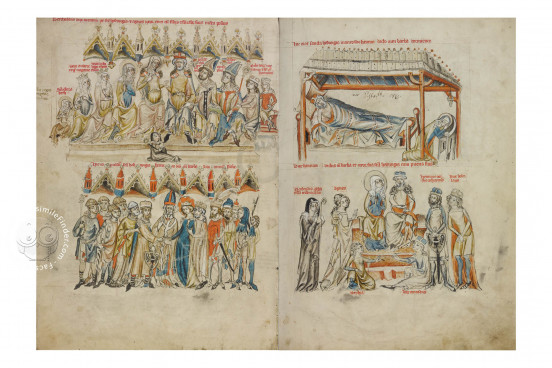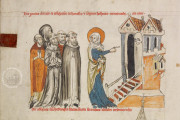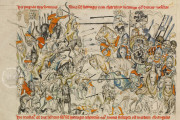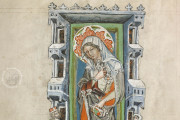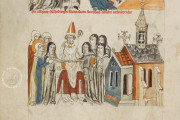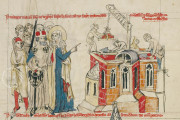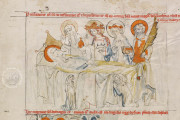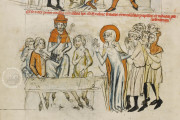The Hedwig Codex is a celebration of the saintly duchess Hedwig of Silesia, who lived from 1174 to 1243 and was renowned for her exemplary charitable deeds, intense piety, and humility. Her fifth-generation descendant Ludwig I of Liegnitz and Brieg, together with his wife Agnes of Glogau, commissioned this manuscript in 1353. The manuscript remains a prime testament to the richness of fourteenth-century central European painting.
Preserved in its original fourteenth-century binding, the Hedwig Codex includes the earliest illustrated copy of the Vita beatae Hedwigis. In addition to the dramatic full-page frontispiece, thirty-two additional full-page miniatures executed in tempera and colored washes are dedicated to the life and deeds of Saint Hedwig. Complementing the main Legenda maior and Legenda minor is a collection of texts related to the saint including the papal bull authorizing her canonization, a sermon related to her canonization, and the interpretation of her name.
Illustrating a Model of Royalty
The images dedicated to the life and deeds of Hedwig appear in two registers with captions above each in red. These miniatures visually narrate the saint's characteristic acts of compassion, her tireless patronage, and her fervent religious devotion alongside some historically significant events, such as the Tartar invasion of Silesia. The use of colored washes adds to the quick and casual style of these images: the miniatures are thus animated with movement while conveying rich details of daily life at a late medieval court. As no iconographic model was available depicting the life of Hedwig, these drawings are also significant as original creations.
The masterly frontispiece operates outside the realm of this narrative, offering a full-page illustration of a statuesque Saint Hedwig in vivid colors (fol. 12v). The manuscript's patrons, Duke Ludwig and his wife Agnes, kneel on either side of the saint and situate this image within the context of the manuscript's creation. Much as readers held the book open in their hands, Hedwig's hands are occupied with the multiple symbols of her devotion: she holds her ivory statuette of the Virgin and Child tight to her chest while her rosary follows the gentle curve of her body and draws the viewer to her elegant garments. Her boots are slung over her right arm, and the folds of her delicate robes lead the eye to her bare feet peeking out at the bottom. She holds a prayer book with a beautiful, decorated binding, her fingers carefully marking her place.
Signed and dated
An inscription identifies the main scribe of the manuscript as Nicolaus of Prussia (fol. 148r). Nicolaus served as a notary to Bishop Przeclaw of Pogorzela, a prolific patron and notable diplomat serving in Holy Roman Emperor Charles IV's court. His engagement as a scribe in this manuscript is evidence of Duke Ludwig's elite cultural connections.
A Saintly Relic Surviving the Salt Mines
Like his illustrious great-great-grandmother, Ludwig I was an active patron of the arts and the church. This manuscript begins with a genealogical table spread over an opening that maps Hedwig's (and thus Ludwig's) sacred lineage (fols. 9v-10r). Emphasizing his ties with his saintly ancestors in the Piast line helped promote Ludwig at the court of the Holy Roman Emperor in Prague. Upon Ludwig's death, the manuscript was donated to the monastery dedicated to Hedwig at Brieg, where the codex was treasured.
The Hedwig Codex's modern history is nothing short of miraculous: while in the illustrious collection of Viennese entrepreneur Rudolf von Gutmann, the manuscript was seized by the Third Reich and transferred to the Österreichische Nationalbibliothek in Vienna. In the company of other inestimable art treasures, it was stored in the salt mines near Altaussee during World War II, which only narrowly avoided destruction. After its recovery and restitution, Gutmann sold the manuscript to the dealer H. P. Kraus, who detailed the story of the dramatic transaction in his autobiography.
Silesian Eagles and Bohemian Lions
Despite its turbulent history, the Hedwig Codex is still in its original fourteenth-century binding of red-dyed pigskin over wooden boards. In addition to the central boss inscribed with Hedwig’s name, both covers have brass corner pieces with open work designs in the form of Silesian eagles and Bohemian lions, which were crucial to the emblematic identity of the family.
We have 1 facsimile edition of the manuscript "Hedwig Codex": Der Hedwigs-Codex von 1353 facsimile edition, published by Gebr. Mann Verlag, 1972
Request Info / Price
